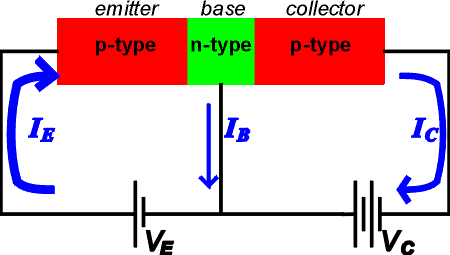
Transistors
Transistors are the major element of modern electronics. They serve as amplifiers in audio and video equipment, and as electronic switches in computers. The basic principle is that a transistor can control its output current according to small changes in the input, much as a light switch can control hundreds of watts power at the flick of a finger.
A pnp transistor is constructed by sandwiching a thin layer of n-type semiconductor between two segments of p-type material.

 Thus a small change in the voltage
VE creates a large effect in the
output current IC.
As described, the transistor can serve as either a switch or an amplifier.
The circuit diagram for the transistor is shown on the right. The wire with
the arrow represents the emitter; the central wire (shown here going downward)
is the base, and the remaining wire (shown here at the upper right) is the
collector.
Thus a small change in the voltage
VE creates a large effect in the
output current IC.
As described, the transistor can serve as either a switch or an amplifier.
The circuit diagram for the transistor is shown on the right. The wire with
the arrow represents the emitter; the central wire (shown here going downward)
is the base, and the remaining wire (shown here at the upper right) is the
collector.